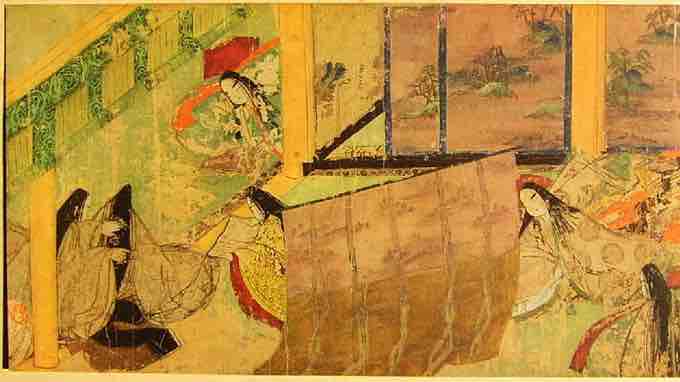Calligraphy in the Heian Period
In the Heian period, a style of calligraphy emerged that was unique to Japan. Writing had been popularized and the kana syllabary was devised to deal with elements of pronunciation that could not be written with the borrowed Chinese characters. At the time, Japanese calligraphers still fitted the basic characters, called kanji (漢), into the squares laid out centuries before.
Soukou Shujitsu is regarded to be the first text that shows a style unique to Japanese calligraphy. This Tanka (短) poem was written in 749 CE and shows some differences from Chinese calligraphy. The authentically Japanese wayō (和) style, or wayō-shodō (和), is considered to be founded by Ono no Michikaze (894-966 CE), one of the so-called sanseki (三, "Three Brush Traces"), along with Fujiwara no Sukemasa and Fujiwara no Yukinari. The "Cry for noble Saichō", a poem written by Emperor Saga on the occasion of Saichō's death, was one of the examples of such a transformation. Ono no Michikaze served as an archetype for the Shōren-in school, which later became the Oie style of calligraphy. The Oie style was later used for official documents in the Edo period and was the prevailing style taught in the terakoya schools of that time.
Soukou Shujitsu
Soukou Shujitsu is regarded to be the first text that shows a style unique to Japanese calligraphy. This Tanka (短) poem was written in 749 CE and shows some differences from Chinese calligraphy.
Emaki
In the last century of the Heian period, the horizontal, illustrated narrative handscroll, known as emaki, came to the fore. Dating from about 1130, the Genji Monogatari Emaki, a famous illustrated Tale of Genji, represents the earliest surviving yamato-e handscroll, and is considered one of the high points of Japanese painting. Written about the year 1000 by Murasaki Shikibu, a lady-in-waiting to the Empress Akiko, the novel deals with the life and loves of Genji and the world of the Heian court after his death. The 12th-century artists of the emaki version devised a system of pictorial conventions that convey visually the emotional content of each scene.

Panel from the Genji Monogatari Emaki pictorial scroll
A scene from the Illustrated scroll of the Tale of Genji (written by Murasaki Shikibu in the 11th century). The multi-panel curtain at the center bottom of the image is a kichō. The decorated sliding door panels at the top of the image are fusuma. The scroll was made in about c. 1130 CE and is in the Tokugawa Museum in Nagoya, Japan.
In the second half of the century, a different, livelier style of continuous narrative illustration became popular. The Ban Dainagon Ekotoba (late 12th century), a scroll that deals with an intrigue at court, emphasizes figures in active motion depicted in rapidly executed brush strokes and thin but vibrant colors.
Emaki also serve as some of the earliest and greatest examples of the otoko-e ("men's pictures") and onna-e ("women's pictures") styles of painting. There are many fine differences in the two styles, appealing to the perceived aesthetic preferences of the genders. Perhaps most easily noticeable are the differences in subject matter. Onna-e, epitomized by the Tale of Genji handscroll, typically deals with court life, particularly the court ladies, and with romantic themes. Otoko-e, on the other hand, often recorded historical events, particularly battles. The Siege of the Sanjō Palace (1160), depicted in the "Night Attack on the Sanjō Palace" section of the Heiji Monogatari handscroll, is a famous example of this style.
Mandalas
The central role of ritual in Japanese Esoteric Buddhism led to a flourishing of religious painting and mandalas in the Heian period. These paintings provided practitioners with ways to contemplate Buddhist deities and concepts. A famous example of a mandala from the Shingon school of Buddhism is the Taizokai (Womb World) mandala. Part of the Mandala of the Two Realms, the Womb World is composed of 12 zones representing different dimensions of Buddha nature. The Shingon sect believed that all beings have an innate Buddha nature. In the center sits the Vairocana Buddha within the lotus of compassion, surrounded by attendant Buddhas and Bodhisattvas.
Taizokai (Womb World) mandala (Second Half of the Ninth Century)
The center square represents the young stage of Vairocana Buddha. (hanging scroll, color on silk)